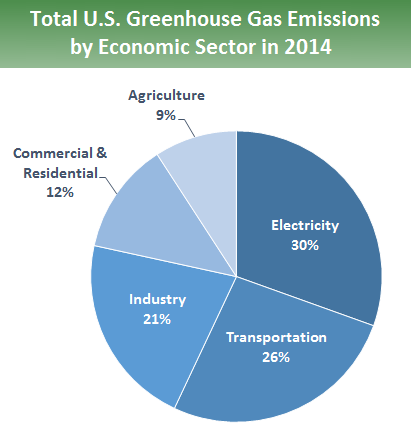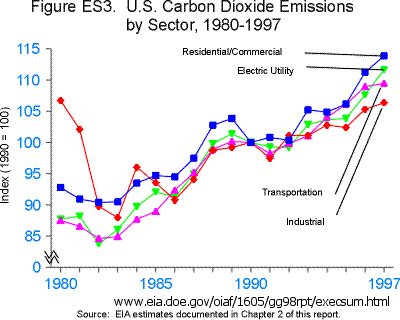|
Global Warming | Renewable Energy | Energy Stats | Green Living | Green Buildings | Transportation | Geo Engineering
- Carbon Dioxide (CO2): Carbon dioxide enters the atmosphere through the burning/combustion of fossil fuels (oil, natural gas, and coal), solid waste, trees and wood products, and also as a result of other chemical reactions (e.g., manufacture of cement). Carbon dioxide is also removed from the atmosphere (or "sequestered") when it is absorbed by plants as part of the biological carbon cycle.
- Methane (CH4): Methane is emitted during the production and transport of coal, natural gas, and oil. Methane emissions also result from livestock and other agricultural practices and by the decay of organic waste in municipal solid waste landfills.
Methane in the atmosphere is eventually oxidized, producing carbon dioxide and water. As a result, methane in the atmosphere has a half life of seven years.
- Nitrous Oxide (N2O): Nitrous oxide is emitted during agricultural and industrial activities, as well as during combustion of fossil fuels and solid waste.
Nitrous oxide reacts with ozone and is the main naturally occurring regulator of stratospheric ozone.
- Industrial Gases:
- Fluorinated Gases: Hydrofluorocarbons (HFC), perfluorocarbons (PFC), and sulfur hexafluoride are synthetic, powerful greenhouse gases that are emitted from a variety of industrial processes. Fluorinated gases are sometimes used as substitutes for ozone-depleting substances (i.e., CFCs, HCFCs, and halons). These gases are typically emitted in smaller quantities, but because they are potent greenhouse gases, they are sometimes referred to as High Global Warming Potential gases ("High GWP gases").
They were introduced as alternatives to ozone depleting substances [chlorofluorocarbons (CFCs) and Hydrochlorofluorocarbon (HCFC)] in serving many industrial, commercial, and personal needs.
- Sulfur hexafluoride (SF6)
Terms:
Greenhouse gases are:
Anthropogenic - Manmade - Primarily burning fossil fuels.
Natural - Methane from bacterial breakdown of organic matter in wetlands
Nitrous Oxide is released naturally from oceans and bacteria in soils
Carbon dioxide from decaying trees, forest fires, volcanos, ...
Water Vapor
They keep the earth about 60° warmer than it woud be otherwise.
Radiative forcing (RF) - the change in net irradiance (solar plus longwave) at the tropospause.
It is used in formulas to compute temperature change on the ground.
measured in Watts per square meter (W/m2)
ppm - Parts per million
ppb - Parts per billion
Glossary here
The Intergovernmental Panel on Climate Change's (IPCC) Fourth Assessment Report (AR4) in 2007 lists the Atmospheric concentrations of greenhouse gases.
Sources of Greenhouse Gas Emissions | Greenhouse Gas (GHG) Emissions | US EPA

 Each gas measured on a CO2-equivalent, or the amount of CO2 that would have the same global warming potential (GWP). Each gas measured on a CO2-equivalent, or the amount of CO2 that would have the same global warming potential (GWP).
| Gas | % Effect | x CO2 | increase |
| CO2 | 76.7% | 1 | 38% |
| NO2 | 7.9% | 310 | 16% |
| CH4 | 14.3% | 21 | 149% |
| HFC | 1.1% | 140-
11K | |
|
See: Global Emissions | Climate Change | US EPA
x CO2 - Times the warming effect of CO2 per unit weight or CO2 equivalent
Fossil Fuel Emission Levels
- Pounds per Billion Btu of Energy Input |
| Pollutant |
Natural
Gas |
Oil |
Coal |
| Carbon Dioxide |
117,000 |
164,000 |
208,000 |
| Carbon Monoxide |
40 |
33 |
208 |
| Nitrogen Oxides |
92 |
448 |
457 |
| Sulfur Dioxide |
1 |
1,122 |
2,591 |
| Particulates |
7 |
84 |
2,744 |
| Mercury |
0.000 |
0.007 |
0.016 |
| Source: EIA - Natural
Gas Issues and Trends 1998 |
When burning a fossil fuel (hydrocarbon) in air at high temperatures some of the nitrogen (N) in the air will be converted to Nitrous Oxides (NOx). Example below for butane (CH4), but it is similar for more complex hydrocarbon fuels such as gasoline.
CH4 + 2O2 + N2 → CO2 + 2H2O + N2 + CO + NOx + heat
Sources of CO2 and greenhouse gasses
  
Source: Greenhouse Gases, Climate Change, and Energy from the Energy Information Administration (EIA) at the Dept. of Energy (DOE)
Water Vapor vs CO2
Statements to the effect that water vapor is more important as a greenhouse gas are simplistic in terms of a CO2-induced radiative forcing.
The concentration of CO2 is relatively constant through the troposphere whereas H2O decreases rapidly. CO2 longwave effects are most important at altitude, where the H2O mixing ratio is much lower than near the surface.
See: Is Carbon Dioxide evenly distributed throughout the atmosphere? - Yahoo! Answers
Links:
Greenhouse Gas Emissions | Climate Change | U.S. EPA
Grass-fed vs Grain-fed beef
Source of CO2 emissions
Climate Change Science Compendium from the United Nations Environment Programme (https://www.unep.org/)
Greenhouse Gas at Wikipedia
The Greenhouse Gases, Regulated Emissions, and Energy Use in Transportation
last updated 1 May 2010
|


